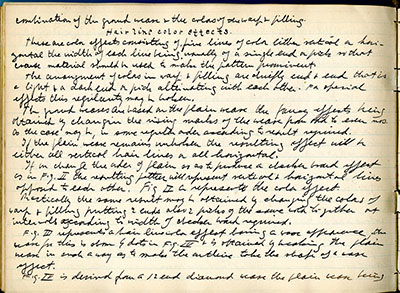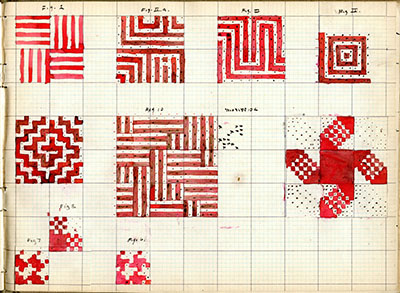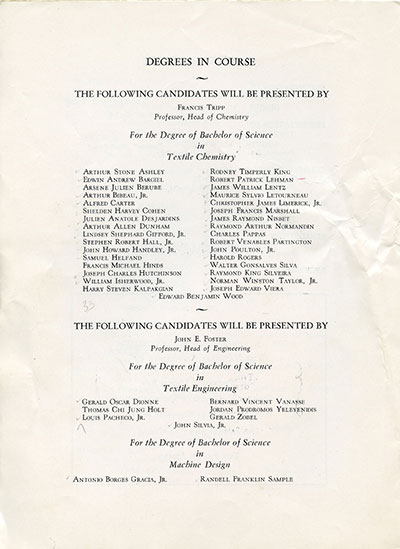Archives & Special Collections
Hours, Policies and and Access
Mission Statement and Collection Policy
Donating to the Archives and Special Collections
Collections
History of UMass Dartmouth & the University Archives
Southeastern Massachusetts Historical Collection
Paul Rudolph & His Architecture
Archives of the Center for Jewish Culture
Franco-American Historical Collections
Congressman Barney Frank Archives Collection
Howard T. Glasser Archives of Folk Music and Letter Arts
The Textile Industry & Textile Education in Massachusetts, 1895-1947

The Archives and Special Collections holds a number of textile-related items in its collections. The “predecessor” schools of the University of Massachusetts Dartmouth were two state textile schools, the Bradford Durfee Textile School in Fall River, and the New Bedford Textile School in New Bedford. Textile manufacturing dominated the region in the early part of the 20th century. After the decline of the whaling industry in the mid-19th century, leading local businessmen invested heavily in textiles and the region became one of the leading cotton cloth manufacturing centers in the Northeast. At the height of the industry, Fall River and New Bedford had over one hundred mills between them. This created a demand for skilled labor, as well as designers, textile chemists and mill managers. When the mills first opened in the mid-nineteenth century, skilled labor was imported from England, while the unskilled jobs went to local residents and the thousands who immigrated to the region from different countries to take advantage of these jobs. In order to create a local skilled labor pool, mill owners petitioned the legislature to open state-funded textile schools. Three were chartered in 1895: one in Lowell; one in New Bedford; and one in Fall River.
The Archives and Special Collections hold many important primary resources for documenting textile education in the United States. Below is an example of a student design manual from 1903 compiled by T. Wilson Williamson, a student in the day program at New Bedford Textile School. The two-page spread shows his notes on hairline color effects on the left, and at right are hand-drawn and colored diagrams of the thread patterns. The instructor was Samuel Holt, and the course was “Designing,” part of the two-year Regular Cotton Manufacturing Course. The Archives and Special Collections owns several similar design books and pattern books. For a list, see URC 5, Textile Student Design Work, Lecture Notes and Pattern Books, 1906-1968. For minutes of the trustee meetings of the two schools, see URC 1 (NBTS) and URC 2 (BDTS). Graduation programs are located in URC 17 and newspaper clippings in URC 18 (NBTS) and URC 19 (BDTS). At this time these collections can only be accessed onsite. Please contact the Archives and Special Collections to view any of these collections. Appointments are suggested.


New Bedford Textile School to New Bedford Textile Institute (NBTI)
Throughout the school’s early days the courses remained almost the same. There were four departments: Cotton Carding and Spinning Department, Warp Preparation and Weaving Department, Design Department, and the Mechanical Drawing Department. During the 1920s and 1930s the curriculum at the New Bedford Textile School expanded to include knitting technology, chemistry of textiles, dyeing and finishing and fashion and textile design. In the 1940s courses in economics and merchandising were added in response to changes in the field. The years following World War II saw many changes in the curriculum. A machine design department developed from the Mechanical Drawing, which in turn evolved into an engineering department.

From 1945 on, school officials started planning for the authority to grant degrees, and in 1950, the first degrees were awarded to 33 students for earning a Bachelor of Science in Textile Chemistry; seven students for earning the degree of Bachelor of Science in Textile Engineering; and two students for earning the degree of Bachelor of Science in Machine Design. First on the stage was Arthur Stone Ashley, who is memorialized in a photograph of President George Walker shaking his hand.
In 1946 (Acts and Resolves of 1946, Chapter 257) the school changed its name to New Bedford Textile Institute; in 1953 to the New Bedford Institute of Textiles and Technology (Acts and Resolves of 1953, Chapter 488); in finally in 1957 to the New Bedford Institute of Technology (Acts and Resolves of 1957, Chapter 347), all to reflect a changing curriculum and goals.
